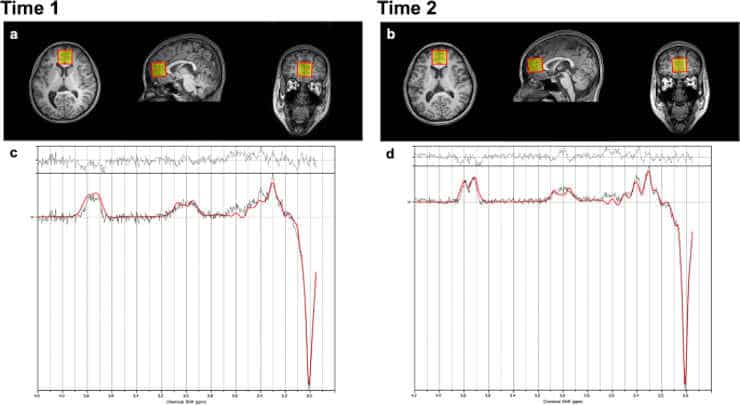Teens who are bullied by their peers are more likely to experience early psychotic episodes, which is linked to decreased levels of a critical neurotransmitter in the area of the brain responsible for controlling emotions, according to new research.
This research implies that a particular neurotransmitter might be a good candidate for pharmaceutical treatments meant to lower the incidence of psychotic disorders.
Psychosis is a mental state characterized by loss of contact with reality, incoherent speech and behavior, and typically hallucinations and delusions seen in psychiatric disorders such as schizophrenia.
Anterior Cingulate Cortex Glutamate
Recent studies investigating links between neurological and psychiatric features of certain disorders have found that individuals who experience their first episode of psychosis or have schizophrenia that remains treatable, have lower-than-normal levels of glutamate, a neurotransmitter in the brain’s anterior cingulate cortex (ACC) region.
The ACC is known to play a crucial role in regulating emotions, decision-making and cognitive control, while glutamate is the most abundant neurotransmitter in the brain and is involved in a wide range of functions, including learning, memory and mood regulation.
Since changes in glutamate levels have been linked to a number of psychiatric conditions, such as anxiety, depression, and schizophrenia, ACC glutamate level measurement can offer important new information about the nervous system mechanisms underlying these conditions and how to treat them.
However, until now, changes in glutamate levels in the ACC in those individuals at high risk of psychosis, and the relationship between this and the effects of bullying in adolescents has remained unclear.
Tracking Bullying Victimization

Voxel-of-interest (VOI) placements for the participant at Time 1 (a) and Time 2 (b) are demonstrated. Credit: Mol Psychiatry (2024). Doi: 10.1038/s41380-023-02382-8
Researchers at the University of Tokyo used magnetic resonance spectroscopy, or MRS, a type of radiological imaging to depict brain structure and function, to measure the glutamate levels in the ACC region of Japanese adolescents.
Afterwards, they took another measurement of the glutamate levels, which allowed them to evaluate changes over time and compare these changes to bullying experiences — or the absence of them — as well as to the intention of the bullied individuals to seek assistance.
Bullying victimization was tracked using questionnaires completed by adolescents. The researchers then used formalized psychiatric measurement to assess bullying victimization experiences based on the questionnaires, such as tallying the frequency and nature of physical or verbal aggression events, as well as capturing their impact on overall mental health.
Subclinical Psychotic Experiences
They determined that bullying was associated with greater levels of subclinical psychotic experiences in early adolescence — symptoms that are similar to psychosis but do not fulfill the complete criteria for a clinical diagnosis of a psychotic condition, such as schizophrenia. These symptoms or experiences, such as hallucinations, paranoia, or radical changes in thought or behavior, can have a major influence on well-being and functioning, even in the absence of a psychotic disorder diagnosis.
“Studying these subclinical psychotic experiences is important for us to understand the early stages of psychotic disorders and for identifying individuals who may be at increased risk for developing a clinical psychotic illness later on,”
said lead author Naohiro Okada, project associate professor at the University of Tokyo’s International Research Center for Neurointelligence.
Crucially, the researchers found that higher levels of these subclinical psychotic experiences were associated with lower levels of anterior cingulate glutamate in early adolescence.
Anti-bullying Intervention
In order to lower the risk of psychosis and its subclinical precursors, anti-bullying programs in schools that emphasize encouraging positive social interactions and decreasing aggressive behaviors are crucial.
“These programs can help create a safe and supportive environment for all students, reducing the likelihood of bullying and its negative consequences,”
said Okada.
Another potential intervention is to provide support and resources for adolescents who have experienced bullying victimization. This might include counseling services, peer support groups and other mental health resources that can help adolescents cope with the negative effects of bullying and develop resilience.
Okada noted that although his group’s research has identified a possible target for pharmaceutical interventions, nonpharmacological interventions like mindfulness-based or cognitive behavioral therapy might also be able to address this neurotransmitter imbalance.
Abstract
Previous studies reported decreased glutamate levels in the anterior cingulate cortex (ACC) in non-treatment-resistant schizophrenia and first-episode psychosis. However, ACC glutamatergic changes in subjects at high-risk for psychosis, and the effects of commonly experienced environmental emotional/social stressors on glutamatergic function in adolescents remain unclear. In this study, adolescents recruited from the general population underwent proton magnetic resonance spectroscopy (MRS) of the pregenual ACC using a 3-Tesla scanner. We explored longitudinal data on the association of combined glutamate-glutamine (Glx) levels, measured by MRS, with subclinical psychotic experiences. Moreover, we investigated associations of bullying victimization, a risk factor for subclinical psychotic experiences, and help-seeking intentions, a coping strategy against stressors including bullying victimization, with Glx levels. Finally, path analyses were conducted to explore multivariate associations. For a contrast analysis, gamma-aminobutyric acid plus macromolecule (GABA+) levels were also analyzed. Negative associations were found between Glx levels and subclinical psychotic experiences at both Times 1 (n = 219, mean age 11.5 y) and 2 (n = 211, mean age 13.6 y), as well as for over-time changes (n = 157, mean interval 2.0 y). Moreover, effects of bullying victimization and bullying victimization × help-seeking intention interaction effects on Glx levels were found (n = 156). Specifically, bullying victimization decreased Glx levels, whereas help-seeking intention increased Glx levels only in bullied adolescents. Finally, associations among bullying victimization, help-seeking intention, Glx levels, and subclinical psychotic experiences were revealed. GABA+ analysis revealed no significant results. This is the first adolescent study to reveal longitudinal trajectories of the association between glutamatergic function and subclinical psychotic experiences and to elucidate the effect of commonly experienced environmental emotional/social stressors on glutamatergic function. Our findings may deepen the understanding of how environmental emotional/social stressors induce impaired glutamatergic neurotransmission that could be the underpinning of liability for psychotic experiences in early adolescence.
Reference:
- Okada, N., Yahata, N., Koshiyama, D. et al. Longitudinal trajectories of anterior cingulate glutamate and subclinical psychotic experiences in early adolescence: the impact of bullying victimization. Mol Psychiatry (2024). Doi: 10.1038/s41380-023-02382-8
